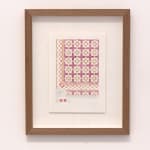Open a larger version of the following image in a popup:
 Image courtesy of Nuhayd Naufal
Image courtesy of Nuhayd Naufal
 Image courtesy of Nuhayd Naufal
Image courtesy of Nuhayd Naufal
Open a larger version of the following image in a popup:
 Image courtesy of the artist
Image courtesy of the artist
 Image courtesy of the artist
Image courtesy of the artist
Noor Mahnun Anum
Penang tiles xi, 2023
Watercolour on paper
29.7 x 21 cm
11.7 x 8.5 inches
11.7 x 8.5 inches
Copyright The Artist
This series of works on paper feature fragments of broken tiles found in the homes of Anum’s friends in Malaysia. It reflects her abiding curiosity towards architecture and the structural...
This series of works on paper feature fragments of broken tiles found in the homes of Anum’s friends in Malaysia. It reflects her abiding curiosity towards architecture and the structural elements of both traditional and modern surroundings. With an acute sensitivity towards colour, Anum captures these floor tiles in vibrant yet diaphanous quality, evoking the delicacy of the material and a wistful sense of passing time. These watercolours often serve as studies that she later integrates into the compositions of her canvases.
Noor Mahnun Mohamed (b. 1964, Malaysia), more widely known as Anum, is an artist, curator, writer and educator. Her practice, largely figurative, comprises painting domestic scenes and still life that fuses elements of realism, allegory and the whimsical. Through which, she weaves subtle psychological narratives with dark wit and emotional depth. Anum focuses on the physicality rather than expressiveness of her figures, which usually seem devoid of emotion, yet each composition is thoughtfully conceived and captures deeply personal moments in her life. In a way, these mise-en-scènes serve as a repository, capturing the banality of life. Formally trained in architecture before pursuing her artistic career, Anum’s works often feature intricate geometric patterns that also reflect her ongoing interest with architecture of her more immediate surroundings in Malaysia and the region, as well as from Europe. The interplay of influences from Southeast Asia and the West—from painterly techniques to symbolic motifs—have been informed by the artist’s personal experiences, and her wry observations of life gestures towards broader commentary around femininity, labour and memory.
Noor Mahnun Mohamed (b. 1964, Malaysia), more widely known as Anum, is an artist, curator, writer and educator. Her practice, largely figurative, comprises painting domestic scenes and still life that fuses elements of realism, allegory and the whimsical. Through which, she weaves subtle psychological narratives with dark wit and emotional depth. Anum focuses on the physicality rather than expressiveness of her figures, which usually seem devoid of emotion, yet each composition is thoughtfully conceived and captures deeply personal moments in her life. In a way, these mise-en-scènes serve as a repository, capturing the banality of life. Formally trained in architecture before pursuing her artistic career, Anum’s works often feature intricate geometric patterns that also reflect her ongoing interest with architecture of her more immediate surroundings in Malaysia and the region, as well as from Europe. The interplay of influences from Southeast Asia and the West—from painterly techniques to symbolic motifs—have been informed by the artist’s personal experiences, and her wry observations of life gestures towards broader commentary around femininity, labour and memory.







